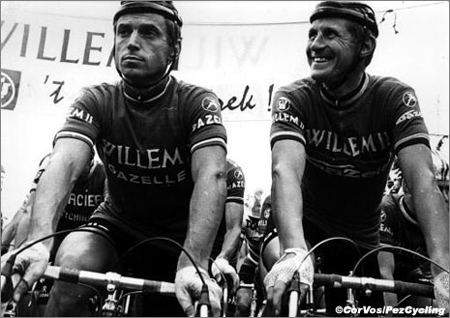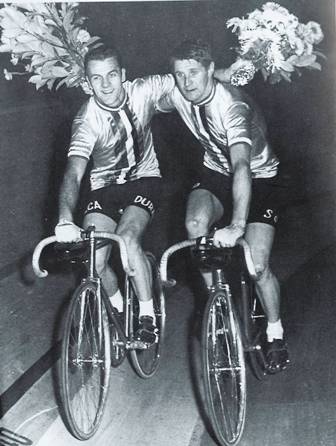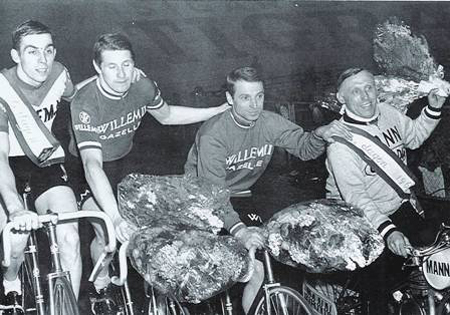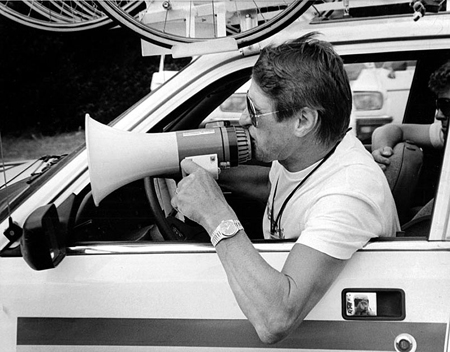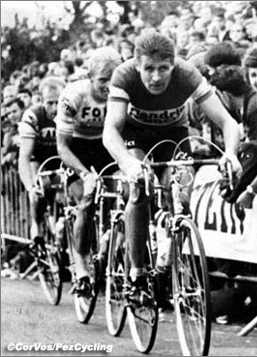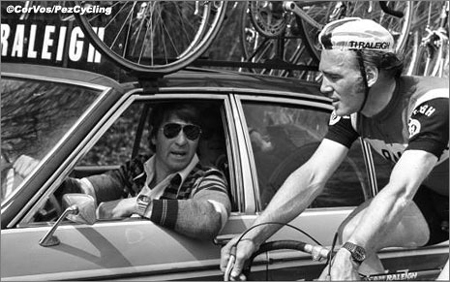Stan Higginson 1931 – 2014
 Tue, September 9, 2014
Tue, September 9, 2014 
Former British National 25 Mile TT Champion and Competition Record Holder, Stan Higginson, died on August 31st. He would have been 83 on the 20th of September.
On May 1st, 2009 I wrote an article here titled “The Higginson Twins: A Pedaling Phenomenon.” Back in 1952 the year I started racing at the age of 16, the two fastest time-trialists for the 25 mile distance were Stan Higginson and his twin brother Bernard Higginson. The picture above is a recent one of the twins, Stan is on the right.

Picture left: From 1952. Stan on the left, Bernard right.
In the 1950s and before that time, British Time - Trial events were almost exclusively ridden on a single fixed wheel.
It was common back then to ride thought the winter months on a single fixed sprocket with a gear ratio around 20 x 48 or 21 x 48, a gear in the lower 60 inch range.
A popular early season event back then was a 72 inch gear restricted 25 mile TT.
Everyone was restricted to a gear ratio no bigger than 48 x 18, which leveled the playing field and those who had learned to pedal fastest during the winter prevailed.
The 25 mile competition record (Unrestricted.) in 1952 was 57 minutes something. It was still a huge achievement for anyone to beat the hour for a 25, a feat that only a few top riders could manage. Stan and Bernard Higginson made history that year when they both beat the hour in a 72 inch restricted event.
Stan’s time was 59 mins. 20 secs, which meant he was pedaling at over 118 revs per minute for 25 miles. Bernard Higginson clocked 59. 48 for 2nd place and third that morning was the previous year, 1951 25 record holder, Dave Keeler with a time of 59.58.
As a result of posting the above article, Stan contacted me and shared with me some interesting pieces of information. He and Bernard normally raced on a single fixed gear of 84.4 inches. (50 x 16) He said it suited their slight build of 5’ 9 1/2” (176.5cm.) weighing 129 lb. (58.5kg.) and their very low profile positions.

Throughout the winter they trained on 62 inch gear. (46 x 20) This no doubt gave the twins their fast pedaling abilities.
Between 1952 and 1955 they won seven British National 25 Mile Championship Medals. 3 firsts, 2 seconds, and a third. Stan Higginson broke competition record 3 times. Their team. Halesowen C&AC won 3 National Championships, and broke competition record 4 times.
Stan’s fastest 25 was 56min. 21sec. and Bernard’s fastest time was 57min. 05sec.

As a 16 year old, just starting out Stan Higginson was one of my heroes, someone I aspired to be. Even though looking back he was only a few years older than me. As we go through life others inspire us, and hopefully we inspire others.
Stan had apparently had heart problems for the last eleven years. He is survived by his brother Bernard, his wife Helen, and his two children Michael and Carol.
There will celebration of his life is taking place on Monday 15th September at 2pm at St Laurence Church in Alvechurch , Worcs B48 7SB. UK.
To Share click "Share Article" below
 Dave Moulton | Comments Off |
Dave Moulton | Comments Off | 
























